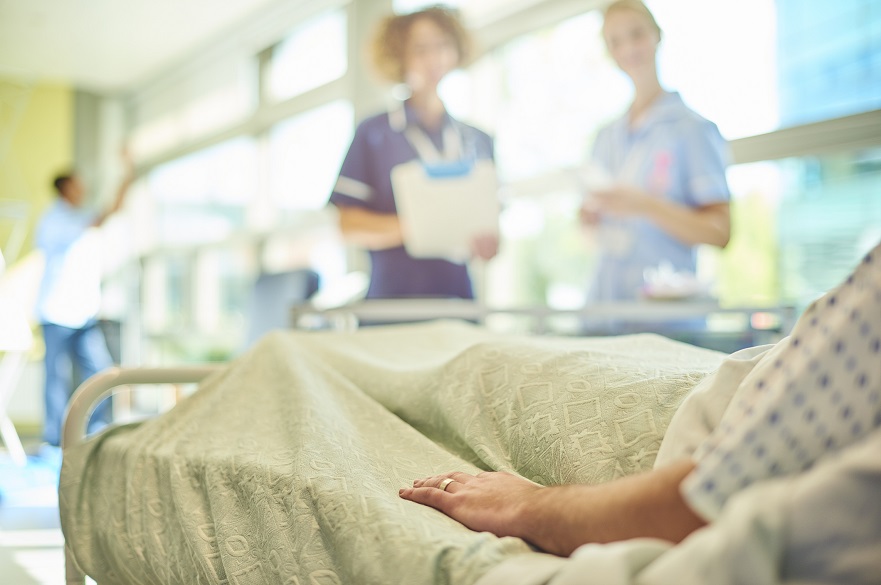Wearable ‘sticker’ that could save lives will help spot changes in patients’ breathing
A wearable ‘sticker’ is being developed which will attach to patients to detect changes in breathing rate and patterns and act as an early warning sensor for declining health.
By Dave Rogers | Published on 14 December 2021
Categories: Press office; Research; School of Science and Technology;

The project, involving Nottingham Trent University, the University of Southampton and University Hospital Southampton, will create a wearable capable of continuously, accurately and remotely monitoring respiration.
Respiratory rate – the number of breaths per minute – is the only vital sign that is not routinely measured by a machine, but it is known to be an effective early indicator of deterioration in a patient’s health.
Changes in breathing rate can be the single earliest sign of patient deterioration in a number of diseases, including sepsis and COVID-19.
It is hoped that work – which also involves med-tech company Zelemiq Ltd and is being made possible with almost £1million from the National Institute for Health Research (NIHR) – will enable faster, more effective treatment and help to save patients’ lives.
The device, which will be about the size of a watch face with a thin respiratory sensor, will be highly sensitive to expansion and contraction of the lungs, without even needing to be in direct contact with the skin.
It is based on the principle of a ‘capacitive reflector’, a device originally developed by NASA as a proximity sensor for collision detection in robots. The team’s earlier work has found that by attaching such a device to the chest, it is possible to detect breathing patterns in people.
Currently breathing rate is measured in hospitals by nurses manually counting the number of breaths taken per minute. This is measured every four to six hours, which can introduce delays to detecting changes and potential treatment.
Chest-band or facemask systems are available for measuring respiration rate
continuously but and can be invasive and uncomfortable for use over long periods of time.
The new device would continuously and accurately monitor breathing rate and be wirelessly interfaced to display data onto dedicated smartphone or tablet app for the healthcare team to use as an early warning system.
The system, which will be low cost and mass manufacturable, will also display a patient’s profile history of respiration rate to enable longer-term trends to be monitored.
The research team say that, as well as being vital for routine measurement in hospitals, the device could also be worn by patients or even healthy people who live at home.
After development there will be a clinical trial with the aim of achieving regulatory approval within the NHS.
“Every year thousands of lives are lost due to sepsis and late detection of respiratory disease,” said researcher Dr Yang Wei, an expert in electronic textiles and electronic engineering in Nottingham Trent University’s School of Science and Technology.
He said: “Changes in breathing rate almost always precede changes in other vital signs and the earlier these changes are detected, the more effective the treatment and the more deaths can be reduced. Unlike a patient’s other vital signs, respiration just can’t be measured routinely currently as the technology is not currently there.
Professor Neil White, University of Southampton added “This will be an early warning system capable of continuous remote monitoring and will identify early declines in patient health thereby saving time, lives and money.”
The three-year project will involve clinicians and engineers and there will be public and patient involvement to help ensure optimal performance and comfort of the device.
Notes for Editors
Press enquiries please contact Dave Rogers, Public Relations Manager, on telephone +44 (0)115 848 8782, or via email.
Nottingham Trent University was named University of the Year 2019 in the Guardian University Awards. The award was based on performance and improvement in the Guardian University Guide, retention of students from low-participation areas and attainment of BME students.
NTU was also the Times Higher Education University of the Year 2017, and The Times and Sunday Times Modern University of the Year 2018. These awards recognise NTU for its high levels of student satisfaction, its quality of teaching, its engagement with employers, and its overall student experience.
It is one of the largest UK universities. With over 37,000 students and more than 4,000 staff located across four campuses, the University injects £1.6bn into the UK economy. It has been the largest recruiter of UK undergraduates in each of the last four years. With an international student population of more than 6,000 and an NTU community representing around 160 countries, the University prides itself on its global outlook.
The university is passionate about creating opportunities and its extensive outreach programme is designed to enable NTU to be a vehicle for social mobility. NTU is among the UK’s top five recruiters of students from disadvantaged backgrounds and was awarded University of the Year in the UK Social Mobility Awards 2019.
The mission of the National Institute for Health Research (NIHR) is to improve the health and wealth of the nation through research. This is done by:
- Funding high quality, timely research that benefits the NHS, public health and social care;
- Investing in world-class expertise, facilities and a skilled delivery workforce to translate discoveries into improved treatments and services;
- Partnering with patients, service users, carers and communities, improving the relevance, quality and impact of our research;
- Attracting, training and supporting the best researchers to tackle complex health and social care challenges;
- Collaborating with other public funders, charities and industry to help shape a cohesive and globally competitive research system;
- Funding applied global health research and training to meet the needs of the poorest people in low and middle income countries.
NIHR is funded by the Department of Health and Social Care. Its work in low and middle income countries is principally funded through UK Aid from the UK government.